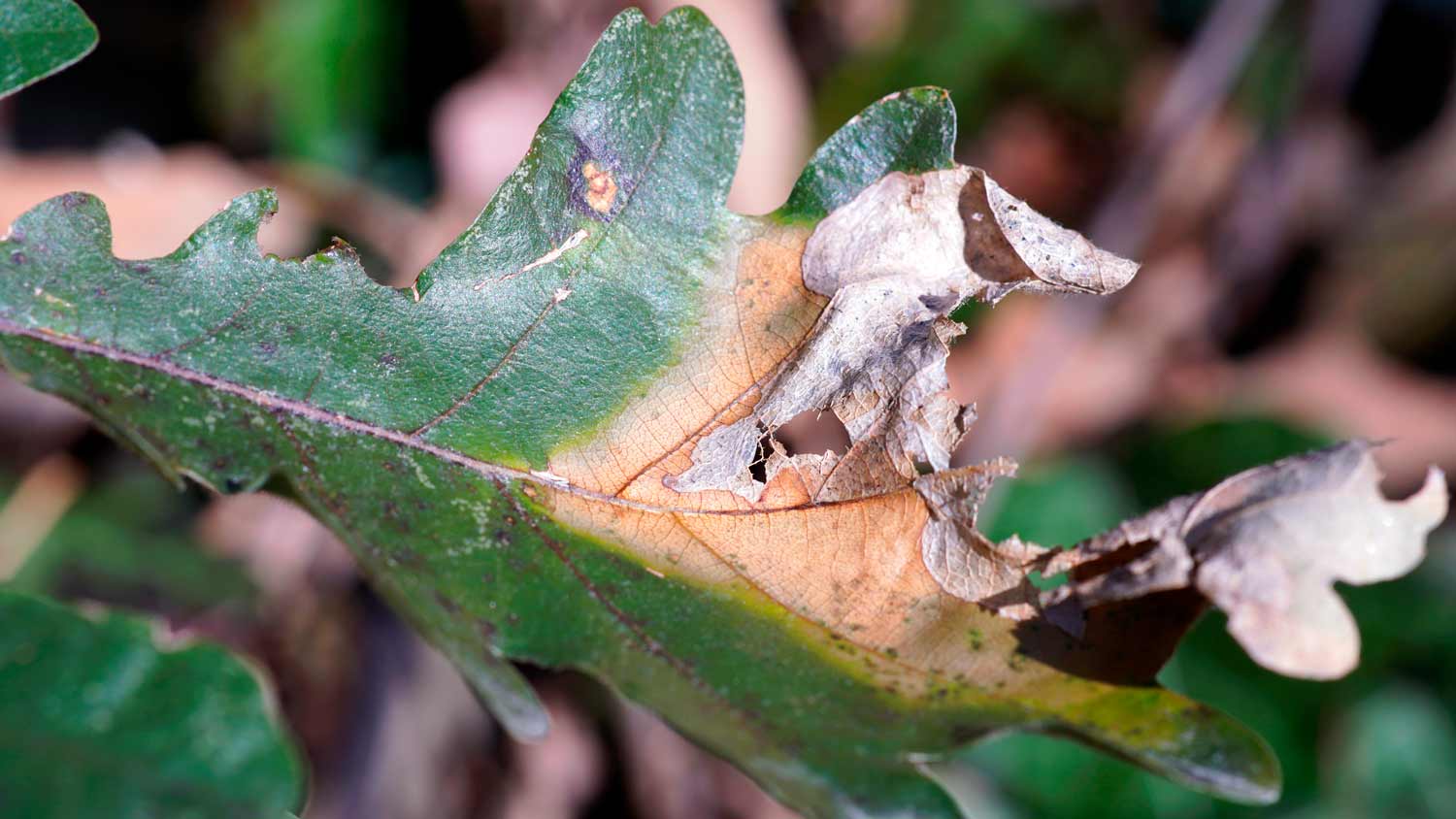What Is Sudden Oak Death? Here Are the Common Symptoms and Solutions
Don’t let this fast-spreading disease take over your yard


Sudden oak death is a tree disease that primarily affects oak trees.
Caused by a pathogen, sudden oak death spreads through soil, wind, and water.
Since there is no cure for it, the best treatment method is prevention.
Make sure to buy trees from reputable sources and remove standing water from your yard.
On a sweltering summer day, the shade of a mature oak tree is a welcome escape. These decades-old beauties can enhance your home’s curb appeal while promoting healthier ecosystems, so long as they stay healthy. Which is why—insert horror music here—sudden oak death can be a literal killer to not only your oak trees but also the surrounding landscaping. So what is this fast-spreading disease? Read on to find out more and learn tips on how to prevent it in the first place.
What Is Sudden Oak Death?
Sudden oak death is a tree disease that can turn a perfectly healthy tree, usually oak, into one at risk of dying. It’s caused by a pathogen called Phytophthora ramorum that produces spores which can spread easily if undetected.
Sudden oak death is most devastating in the coastal forests of California and Oregon. It can affect more than just oak trees, however. It can also spread to surrounding ornamental plants as well as tanoaks and bay laurels.
Signs of Sudden Oak Death

Once first signs of sudden oak death appear, it can spread quickly through wind, rain, and splashing water. It can also survive in the soil and water, because it thrives in moist environments. Here are some initial signs of this harmful disease:
Yellow or brown leaves on the upper canopy
Cankers on the bark
Fruit or seed issues
White or gray fungal growth
Dieback
How to Treat Sudden Oak Death
Although there is no known cure for sudden oak death, there are ways you can try to control the spread of the disease or mitigate the damage it causes. You can remove infected debris to prevent the spread of sudden oak death, so long as you follow local regulations for disposal. You can also try to apply a fungicide early, but you’ll want to ask a local tree maintenance professional for application and solution recommendations. If your trees appear to be past the point of saving, an arborist or other tree expert can help determine if any should be cut down or if there’s still life for them to live.
Tips for Preventing Sudden Oak Death
Because sudden oak death can’t be cured completely, your best form of defense against it is prevention. Here are some steps you can take to help keep the disease at bay:
Clean Tools Regularly
Any landscaping tools should be cleaned in between cuts, whether you’re working on bushes and potted plants or pruning oak trees. This helps prevent the spread of spores produced by sudden oak death so that the disease doesn’t impact your entire yard.
Source Plants Carefully
Before you overhaul your front landscaping or add some new plants to your backyard, research nurseries in your area to determine which ones use the best practices in growing and selling healthy greenery. If you purchase plants or trees from a poorly-run nursery, you could unknowingly bring sudden oak death home with you.
Reduce Standing Water
Sudden oak death can live in soil and excess water, which is why it’s necessary to monitor your yard regularly for standing water or other areas susceptible to warm, wet conditions. This helps eliminate a host for the disease so that it doesn’t set up shop and infect trees and plants.
Frequently Asked Questions
The average lifespan of an oak tree is 100 to 300 years, so long as it isn’t impacted by diseases like sudden oak death. Some species will last shorter or longer, depending on where you live.
You will know that an oak tree needs to be removed when you see vertical cracks or dead branch stubs, which indicate internal decay. Other signs include trunk rot near the base of the tree and sprouts or small branches coming from the trunk.





- What Is Oak Wilt? A Complete Guide
- 15 Tree Fungus Types: How to Identify (and Treat) Them
- The Power of Trees: Learn Which Ones Can Make Your Property Value Flourish
- 9 Ways to Protect Your Trees From Winter Storms
- Can You Cut Down a Tree on Your Property?
- Identifying Plant Heat Stress: How to Protect Your Garden During a Heat Wave
- What Is the Best Wood for Pergolas? 7 Options for Your Backyard Oasis
- How to Tell What Type of Tree You Have in Your Yard
- 13 Essential Landscaping Tips for a Beautiful Spring Garden
- Dutch Elm Disease: Treatment, Symptoms, and More









